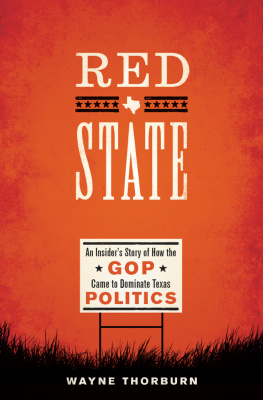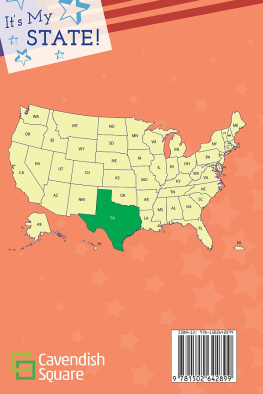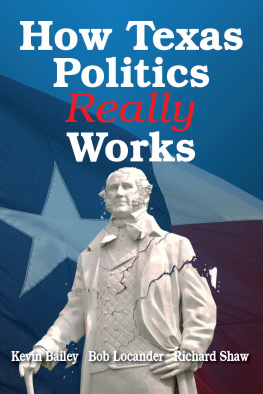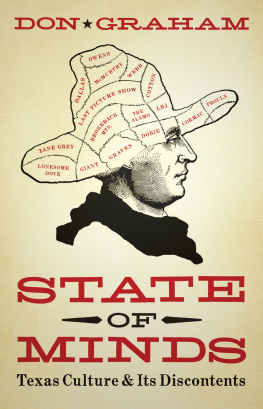Number Forty-Two
Jack and Doris Smothers Series in Texas History, Life, and Culture
Red State
An Insiders Story of How the GOP Came to Dominate Texas Politics
WAYNE THORBURN

University of Texas Press
Austin
Publication of this work was made possible in part by support from the J. E. Smothers, Sr., Memorial Foundation and the National Endowment for the Humanities.
Copyright 2014 by the University of Texas Press
All rights reserved
First edition, 2014
Requests for permission to reproduce material from this work should be sent to:
Permissions
University of Texas Press
P.O. Box 7819
Austin, TX 78713-7819
http://utpress.utexas.edu/index.php/rp-form
Library of Congress Cataloging-in-Publication Data
Thorburn, Wayne J. (Wayne Jacob), 1944
Red state : an insiders story of how the GOP came to dominate Texas politics / Wayne Thorburn. First edition.
pages cm. (Jack and Doris Smothers series in Texas history, life, and culture ; Number Forty-Two)
Includes bibliographical references and index.
ISBN 978-0-292-75920-6 (cloth : alk. paper)
1. TexasPolitics and government1951 2. Republican Party (Tex.)History. 3. Democratic Party (Tex.)History. 4. Political partiesTexasHistory. 5. Party affiliationTexasHistory. 6. Political cultureTexas. I. Title.
JK4816.T56 2014
324.09764'09045dc23
2013046760
doi:10.7560/759206
ISBN 978-0-292-75921-3 (library e-book)
ISBN 9780292759213 (individual e-book)
Preface and Acknowledgments
On the morning of Wednesday, November 9, 1960, Democrats across Texas woke up, and all was well. Their party had wrested back the White House, occupied by the opposition for the last eight years, and the new vice president of the United States was one of their own. Texas had returned to its traditional roots, and the state had been carried by the Democratic presidential candidate once again, albeit in a too-close election. Beyond that one contest, there was little concern. All thirty statewide elective positions, from governor to court of criminal appeals, were in the hands of Democrats. The same picture would be drawn in the Texas legislature: 181 Democrats and no Republicans or anyone else. One lone Republican would sit, however, among the twenty-four Members of Congress representing Texas. Clearly, after a little aberration in the Eisenhower elections, Texas was once again a one-party Democratic state.
Fast-forward fifty years to November 3, 2010, once again the day after an election, and the picture is dramatically different. There was again a Democrat in the White House, but he had achieved election without the support of Texas, a state that had not voted for a Democratic presidential candidate in thirty-four years. Moreover, every statewide elective office was now held by Republicans; no Democratic candidate had won a single statewide position in sixteen years. Representing Texas in Washington was a congressional delegation of twenty-five Republicans and nine Democrats. Republicans controlled the Texas Senate by a margin of nineteen to twelve and had elected ninety-nine of their party to the 150-seat Texas House of Representatives, a number soon to be enhanced by the switch of three Democratic state representatives to the GOP. What had been for more than a century a one-party Democratic state was now clearly a predominantly Republican state.
How did this transformation of Texas politics take place, and what do the recent changes imply for the future? That is the story to be told on the following pages, beginning with a brief overview and background information on Texas itself, followed by a description of the four categories of counties in the state. Attention is then drawn to the extent of political competition in Texas during the 112 years of statehood prior to the election of 1960. Its a story of various factions and forces attempting to compete as a political party against the dominant Democratic Party, with only sporadic and localized success. More recently, however, it is also the story of conflict among ideological groupings within the dominant party, conflict that provided a modicum of choice for Texas voters and that ultimately facilitated the development of a viable alternative political party.
From the end of the Reconstruction era in Texas and the return of the ex-Confederates to the electorate in 1873 until the 1960s, Texas political competition took place within a one-party system. As was true in other states of the Confederacy, that one political force was the Democratic Party. With few exceptions in isolated parts of the state, especially the German-settled Hill Country, Democrats won all elections for public office, Republican candidates rarely appeared, and the actual selection of public officials took place in the Democratic primary.
The first movement away from a one-party system began to appear with the emergence of presidential Republicans, individuals whose opposition to many policies of the New Deal and the national Democratic Party led them to support a Republican candidate for president. At the same time, these individuals continued to view themselves as Democrats and continued to vote in the Democratic primary. By the 1960s and 1970s, cracks were beginning to appear in the Democratic dominance of the states politics, first with the election of John Tower to the United States Senate in 1961 and then several years later the election of Bill Clements as governor. Competition developed first in the states major urban areas, for top-of-the-ticket candidates. As these metropolitan areas expanded geographically, a Republican base began to develop in their suburban counties. At the same time, competition spread to the smaller, outlying metropolitan statistical areas where race, ethnicity, economic base, and extent of union membership had an impact on the degree of competition that developed. It would be much later before partisan change would occur in many of the states rural counties.
By the 1980s Texas had entered into a brief period of true two-party competition, with both major parties able to elect a number of candidates, fewer contests that were settled in the party primary, and growing competition expanding to down-ballot candidates. During the period from 1978 to 1998 the office of governor alternated between the two parties every four years, and for most of this period the state was represented by one Democrat and one Republican in the United States Senate. Beginning with the election of 1996, however, the Republican Party has won every statewide election, eventually acquiring a majority in both chambers of the Texas legislature as well as the congressional delegation. As the twenty-first century began, Texas appeared to have entered a period of one-party politics once again, albeit not to the overwhelming extent of Democratic domination in the previous era.
As the geographical spread of party competition was taking place, so too was it moving down the ballot, limited at first by the visibility of the office. Thus, party competition first took hold in federal elections, followed by gubernatorial elections and then those for the state legislature, bypassing the lower-profile statewide executive and judicial offices. For the individual Texan, changes in voting behavior preceded changes in party identification, which, in turn, preceded changes in primary election participation. Yet, to a large extent, individual conversions have been less significant than the inclusion of new voters in the electorate, comprising both new residents and younger voters. In the following pages, the changes in party competition will be viewed using a number of measures, including perceived party identification, actual affiliation with a political party by participating in its primary, the performance of candidates for statewide elective offices, representation in the U.S. House of Representatives and the state legislature, elections for county offices, and the extent and nature of straight-ticket voting.
Next page











